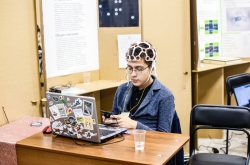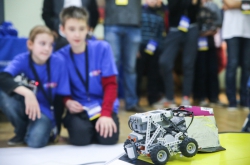Maria Chalova, 4th grade, Moscow
 Maria Chalova
Maria Chalova
I took up robotics after my mother went to a summer camp where there were robotic contests. I went with her, liked the idea, and started going to a robotics class. I am the only person on my team, so I am responsible for both the robot's design and software. I am good at both, yet I like designing robots more. I chose the "Bridges" category, as it was a lot more complex - and interesting - than the "King of the Hill". In fact, I believe I can already design robots for contests in which highschoolers participate, yet I still have to learn a lot.
Dmitriy Samohvalov, Alexander Grigoriev, 7th and 8th grade, St. Petersburg
 Dmitriy Samohvalov and Alexander Grigoriev
Dmitriy Samohvalov and Alexander Grigoriev
When we were invited to the preliminaries in St. Petersburg, we decided to try in two categories, but were selected for "Bridges" only - we’ve spent a lot more time on designing the robot for it. Sumo robots seemed too simple, so we thought that there was nothing new to learn from building one. The "Bridge" robots, on the other hand, allowed us to learn a lot. The most difficult part was to program our robot to stop and perform the necessary actions at the right time. We had to be very patient about it. Yet, everything we did was not in vain. Here at the tournament we met a lot of people, and we really liked the overall atmosphere of excitement and competition.
Sergei Babekyan, Daniil Goriuhin, 8th and 9th grade, St. Petersburg
 Sergei Babekyan and Daniil Goriuhin
Sergei Babekyan and Daniil Goriuhin
In the "Seesaw" category we participated in, precision, not speed, was most important. We had to mind the balance, so that the robots wouldn't outweigh each other, and would move accurately. We got 4th place because we didn't readjust our robots on time. Surely, everyone wants to win, but we are happy anyways, as we got to see how others design their robots and learned a lot from it.
Alexander Kadrov, Andrei Pipilenko, 5th and 6th grade, Moscow
 Alexander Kadrov and Andrei Pipilenko
Alexander Kadrov and Andrei Pipilenko
We really wanted to participate in the "Bridges" category of the tournament, as it was thefirst contest of this kind in Moscow, and we've already participated in many others. We love robotics, as it implies solving new problems and not repeating some routine tasks, though sometimes we have to do that as well. Also, as now it is the age of technology, robotics will be helpful in finding a job in the future. As of now, we like engineering and programming most. The tournaments help us to develop the skills we'll need. For instance, when we were arranged into teams, it wasn't difficult for us to communicate with other participants; the difficulties lied in having to rewrite the programs our robots used, but we managed to do it anyways.
Artem Belyaev, 8th grade, Moscow
 Artem Belyaev
Artem Belyaev
In the "Seasaw" category, writing a program that would provide for the robots' synchronous movement was most difficult. This is why we decided not to write a program that would count time, but make our robots communicate in real-time mode. We used Bluetooth for that. Our team chose the "Seasaw" category, as it was a new contest; I never participated in anything like that. The things I’ve learned when solving the tournament’s tasks will help me become a programmer in the future. Also, when they started to form new teams, it was really interesting to meet other participants. It was a bit hard, as not everyone prepared for the tournament well, so we had to solve these kinds of additional problems. Overall, I think the tournament was well-organized, and I will definitely go to the next tournament in St. Petersburg.
Snejanna Astamentsova, 6th grade, St. Petersburg
 Snejanna Astamentsova
Snejanna Astamentsova
I've been doing robotics for two years already. Actually, I got interested in it by chance; I just chose it when my parents suggested that I do something apart from school. And I never regretted my decision. Robotics is most interesting; you have to solve both engineering and programming tasks. Also, you can participate in contests like this one, make new friends and have a good time.
Marat Anisimov, 8th grade, Moscow
 Marat Anisimov
Marat Anisimov
I chose "Racing", as it seemed easy at first, but actually it proved to be far from that. In the "Seesaw" category the mechanics are a lot more complex, yet the programs aren't. In "Racing", on the other hand, mechanics are simple, but you have to work on the programs really hard. I've been doing robotics for a year, and I am good at it; I learned about the tournament by accident and thought - why not? In future, I plan to enter some technical university.
Alexander Kazin, 10th grade, St. Petersburg
 Alexander Kazin
Alexander Kazin
Our trainer decided to organize a tournament this September, we had a short-track category there. All the robot had to do then was drive along a straight line. Since then, I've been gradually improving the program, and when I was invited to the tournament's preliminaries, I was already ready for the "Racing" category. Surely, each category has its own difficulties, even the "King of the Hill", though the programs there are really simple. In "Racing", you have to write a much more complex program that has to watch out for all junctions and stops. The jury was most adequate, so I liked everything a lot.
Tamara, 10th grade, Moscow
Earlier on, I participated in the EuroBot contest. This tournament was different, as the tasks were different, and there we also didn't know what awaits us in the finals. I specialize in IT, and I want to continue to work in this field. It is indeed very promising. Thanks to robotic contests, one can learn to solve application tasks, which is essential for a potential employer’s point of view: you have to show them that you can quickly solve different tasks. This time, our team included experienced people, which is why we were able to complete all the problems quickly. What's more, we had the opportunity to bring ready robots - at some contests, they make you construct them during the contest.

The Tournament of Two Capitals was conducted for the first time; eight teams from Moscow and St. Petersburg competed in four categories. The younger participants (up to the age of 14) competed in the "Bridges" and "King of the Hill" categories, while the older ones (from 14 to 18) were to participate in "Seasaw" and "Racing". In "King of the Hill", massive robots were to climb the "hill", and then tackle others from it. In "Bridges" category, each team had two robots: one built bridges, and the other tested them. In "Seesaw", one robot had to climb the seesaw and take a cylinder from a shelf, while the other had to hold the seesaw with its weight. In "Racing", robots raced against each other. The final assignment included all of the four categories. The tournament's cup went to a team from St. Petersburg, where the second tournament will take place this autumn.





